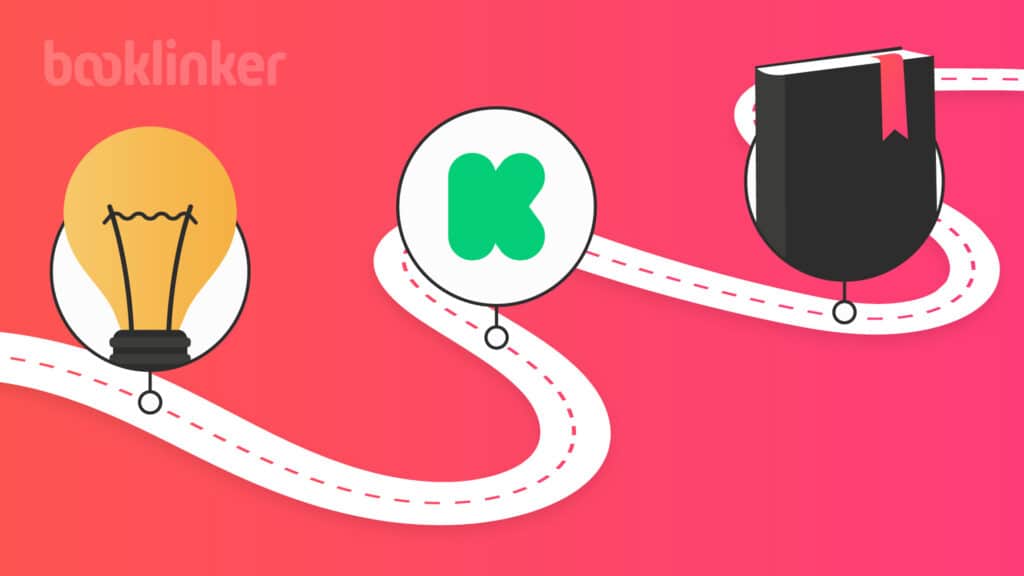
There are a lot of strategies for launching a book including stacking promotions, building pre-launch pre-sales, creating buzz on social media, utilizing an ARC (advanced reading copy) team, doing a blog tour and the list goes on.
But have you ever considered using Kickstarter to launch your book?
More and more authors are turning to this crowdfunding platform to get funds to help cover costs like editing, book cover, book formatting and printing. And they are using it to launch a book or series months before releasing it on the regular platforms like Apple, Kobo and Amazon.
You’re not asking people to give money, you are asking them to be among the first to receive this new book/s and be part of the group that helps make this book a reality.
This post will cover what Kickstarter is, why to consider it for your next book launch and the steps and strategies needed to create a successful campaign. If you are looking for a creative way to launch your book, keep reading.

Key Takeaways
- Kickstarter as a Launch Tool: Kickstarter offers a unique platform for authors to launch and fund their book projects by engaging directly with readers and building a loyal fan base.
- Strategic Planning is Key: Successful campaigns require meticulous planning, including setting realistic funding goals, crafting compelling project descriptions, and preparing engaging visuals and rewards.
- Active Engagement Ensures Success: Maintaining strong communication with backers, promoting the campaign actively, and managing expectations are essential to achieving and surpassing your campaign goals.
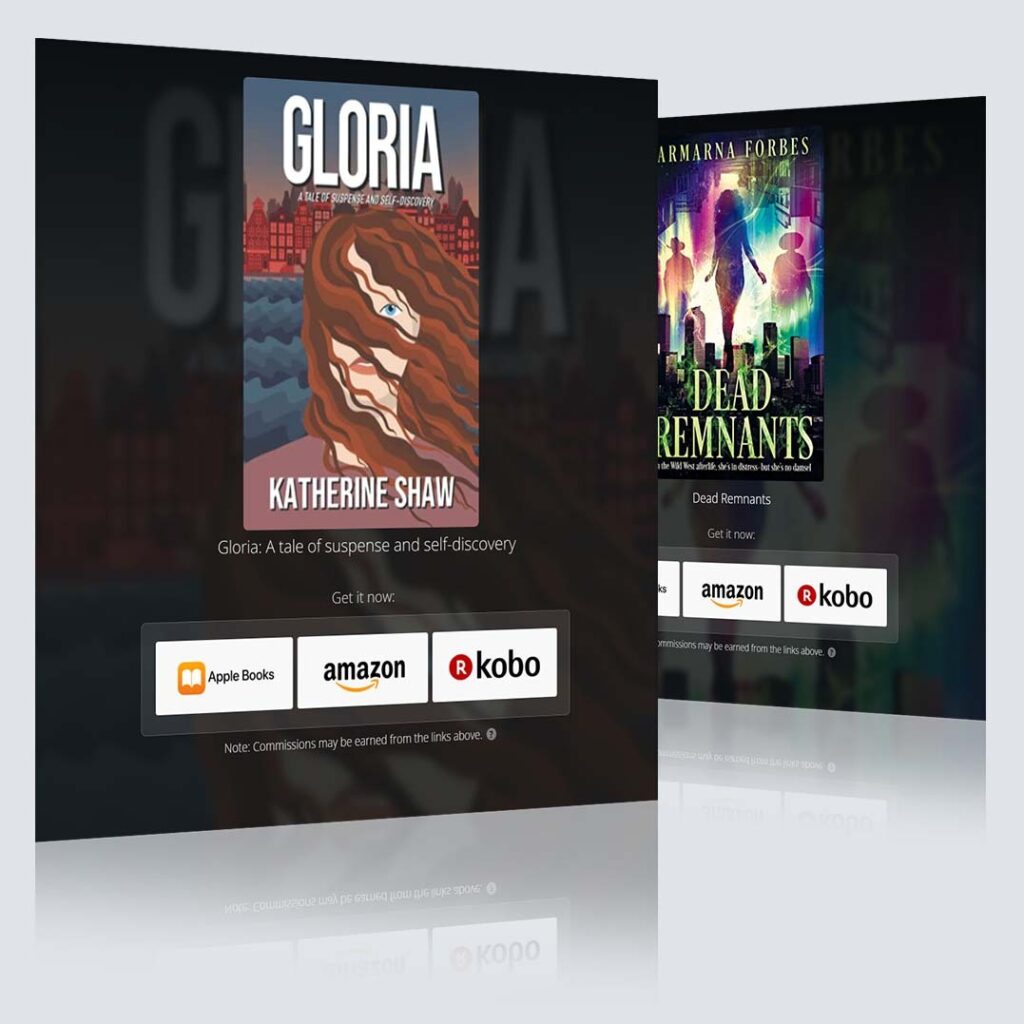
Free Universal Book Links
- Boost international sales by geotargeting readers
- Book store links update automatically based on availability
- Advanced marketing analytics
- Increase clicks with trusted links
What is Kickstarter?
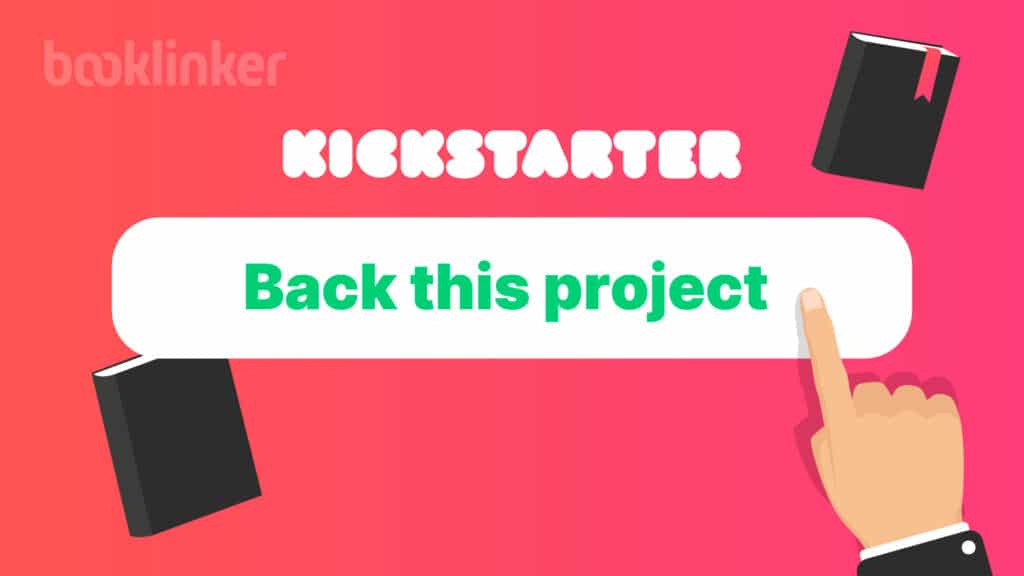
Tip!
- With the goal of bringing creative projects to life, Kickstarter is a crowdfunding platform that allows backers to support and invest in your project, which, in this case, is a book or a series of books.
The platform has been around since 2009 and in 2012, they created their publishing category to help authors, publishers and poets. Since then, they have launched over 66,000 publishing projects and funded over $330,000,000 to these creatives.
There is a perception from some who think that Kickstarter is just authors and other creatives begging for money without providing any value in return.
Yes, you as the author are asking for money, but the difference is, all the backers receive rewards like special editions, ebook sets, playlists, merchandise, artwork and other incentives.
So you are not asking readers to just give you their money, you are asking them to support your project and be part of the process. It’s a chance for them to get exclusive access to items not available anywhere else and connect directly with you.
When you release a book on Amazon, you put your book out there and have no way to communicate with the reader.
Through Kickstarter, you can connect with your backers, thank them for their support and provide updates to them during and after the campaign. This brings them into your circle where you can add them to your email list (with their permission) and they will automatically be notified when you run another Kickstarter campaign.
Why Choose Kickstarter for Your Book Launch?
There is a lot of talk in the indie publishing world about bypassing online bookstores (Amazon, Barnes & Noble, Apple…) and instead selling direct to readers. This allows authors to have control over the messaging, retain more of the profits and be able to stay connected to readers.
But for any authors who have looked into selling direct, there is definitely a learning curve to get this set up, in addition to the time factor.
Kickstarter is a form of direct sales which allows you to become familiar with this idea and try it out on an established platform. Unlike Amazon and other online retailers who keep 35%-65% of the royalties depending on the type of book (ebook, paperback or hardcover) and the costs to produce the book, Kickstarter only keeps 5%.
Projects for Kickstarter need to be new. This can be a special edition of a current book, but you can’t take an existing series that is already for sale and run a campaign for that. You can, however, do one for the next book in the series (that isn’t available yet). As part of your rewards, you can offer existing books, but not for the main campaign.
Planning Your Kickstarter Campaign
Setting Your Goals
When planning your Kickstarter campaign, set a clear and realistic funding goal. List all your potential costs:
- Editing: varies depending on the quality and depth of service required, while cover design should reflect professional standards to attract backers.
- Book cover: it’s always a good idea to hire a professional graphic designer for your cover.
- Printing costs: depends on the book’s format (paperback, hardcover or special edition) and length. BookVault is an excellent Print on Demand (POD) company that produces high quality books at a reasonable price. The minimum you need to buy is ten.
- Marketing expenses: might include promotional materials and paid ads.
Digital products like ebooks, audiobooks and digital artwork can provide great value, because there are no or minimal delivery costs. There are distribution platforms you can use like BookFunnel. You pay a small monthly or annual fee for the service, but that is the only cost involved.
Be meticulous in calculating these expenses to ensure your funding goal covers all necessary aspects. Plus keep in mind shipping costs, which includes shipping boxes, tape and any other materials you will need.
Kickstarter is an all or nothing system. If you set a goal for $1,000 and only receive $950 from your backers, your campaign is considered unsuccessful. None of your backers will be charged anything and you won’t receive any money.
Fantasy author Michael La Ronn ran his first Kickstarter campaign in early 2024. It was for hardcover editions of his successful series, The Good Necromancer. His goal was $200 to cover the printing costs. He ended up raising $4,324 from 101 backers. After the Kickstarter fee of 5%, the total was $4,108, which averaged out to $41 per person.
Michael could have set a goal at $5,000, but then the campaign wouldn’t have been successful. Instead he asked for $200 and exceeded his goal.
Because of this, setting realistic and achievable goals is crucial for maintaining momentum and credibility throughout your campaign. Start with a modest goal that reflects the minimum amount needed to produce your book.
This approach not only makes your campaign more attainable but also allows for the potential of surpassing your goal, creating additional excitement through stretch goals and increased visibility.
Clearly communicate to your backers how the funds will be used, ensuring transparency and building trust. Remember, a successful campaign often funds quickly, allowing you to introduce stretch goals that can further enhance your project.
Research and Preparation
Before launching your campaign, invest time in researching successful projects within your genre.
Analyze what made them successful, from their campaign descriptions to the rewards they offered. Back a few campaigns that interest you and pay attention to how the author engages with their audience and maintains momentum throughout the campaign.
This research can provide valuable insights and strategies that you can adapt to your project, increasing your chances of success.
Understand your target audience. Don’t assume every reader on the planet wants to back your campaign. If your book is already written, you should have a clear picture of your ideal reader.
What is their age, gender, hobbies… By aligning your campaign with your audience’s preferences, you can create a more compelling and effective campaign.
Creating a Timeline
Having done a few Kickstarters myself, I now know there is time involved in planning, during the campaign and fulfilling the orders.
And it is probably more time than you imagine. Start by planning the duration of your campaign; typically, a 30-day campaign is ideal as it creates a sense of urgency while providing ample time for promotion. Break down your timeline into three phases
- Pre-launch: Build your audience and generate interest with social media, influencers and your newsletter.
- Live campaign: Update your backers along the way and promptly respond to any questions or comments.
- Post-campaign: Maintain communication to let them know when and how to expect their rewards.
Each phase should have specific tasks and milestones to ensure you stay on track and cover all necessary steps. This timeline you create will help you manage your efforts effectively and keep your campaign organized and focused, ultimately contributing to its success.
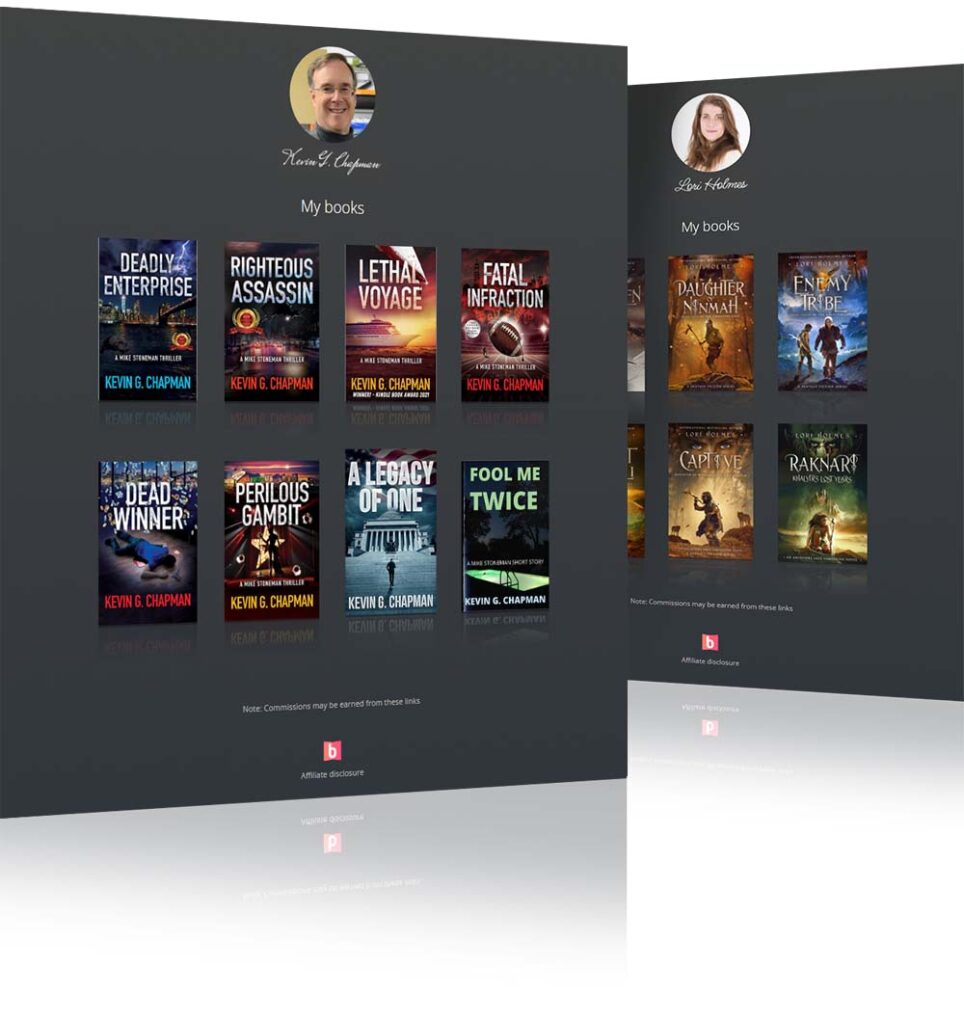
Introducing:
Booklinker Collections
One landing page for all your books. 100% free.
One link for easy sharing of your books across your backmatter, websites, emails, and social media.
Crafting Your Campaign Page
Compelling Project Description
Just like a book description, you want your project page to capture the interest and engage potential backers. Start by writing a clear and engaging story about your book, emphasizing why it matters and the inspiration behind it.
Highlight what sets your book apart from others in the genre, whether it’s a distinctive plot, memorable characters, or an innovative setting.
Part of the draw of Kickstarter is that backers get to feel connected to you and be part of the experience. Share your author journey. What challenges have you had to overcome? What drives you to write? What other authors inspired you?
Personal anecdotes create a connection with your audience, making them feel more invested in your project’s success. Share how you got the idea for the story or series. Share some insider info about one of the characters or setting. Make your backers feel like they are part of something exclusive.
Be transparent about your goals and the steps you’ve taken to ensure the book’s quality, such as working with professional editors and designers. This transparency builds trust and encourages backers who don’t know you, to support your campaign.
Eye-Catching Visuals
Great visuals can make your campaign page stand out and attract potential backers. This starts with your cover. Unless you are a professional graphic designer, hire this out. A good professional designer understands how to reflect the genre and tone of your book and the proper layout. A good cover is worth the investment because this is the first thing a potential backer notices.
Create promotional images that showcase your book in various contexts, such as mockups of the book on a bookshelf, being read, or displayed alongside related merchandise.
A solid video at the top of your campaign page is an engaging way to present your project. A video with you in it explaining your project adds a personal touch to the page. Use the video to show your enthusiasm and passion for the project. This will motivate potential backers to contribute.
If you are not comfortable being on camera, consider a video that is similar to a book trailer. Animoto allows you to make free book trailers.
Remember to keep the video concise and focused, ideally under two minutes, to maintain viewer interest. The video can then be used on social media sites and your website in addition to the Kickstarter campaign page.

Reward Tiers
Trust me, it’s easy to get excited and want to add lots of rewards to your campaign in order to give backers plenty of choices. But more choices isn’t always ideal.
For some exploring your campaign, it can feel overwhelming. And don’t go all in on merchandise (t-shirts, mugs, bookmarks…) for your project. This can become expensive quickly and will require a lot of your time to set up, manage and ship.
Start simple with digital rewards at a lower price point which are easy to deliver and don’t require a trip to the post office and shipping costs. Ebooks, audiobooks, digital art and playlists are good examples of inexpensive and fun rewards.
As you create higher tiers, include more exclusive and tangible rewards such as signed copies, limited edition prints, and special bundles (which can include your other books). You can also get creative and think about ways for readers to connect with you. Maybe a video chat and coffee with you and up to five backers. Send them each a $10 coffee gift card to get a beverage before the call.
Stretch Goals
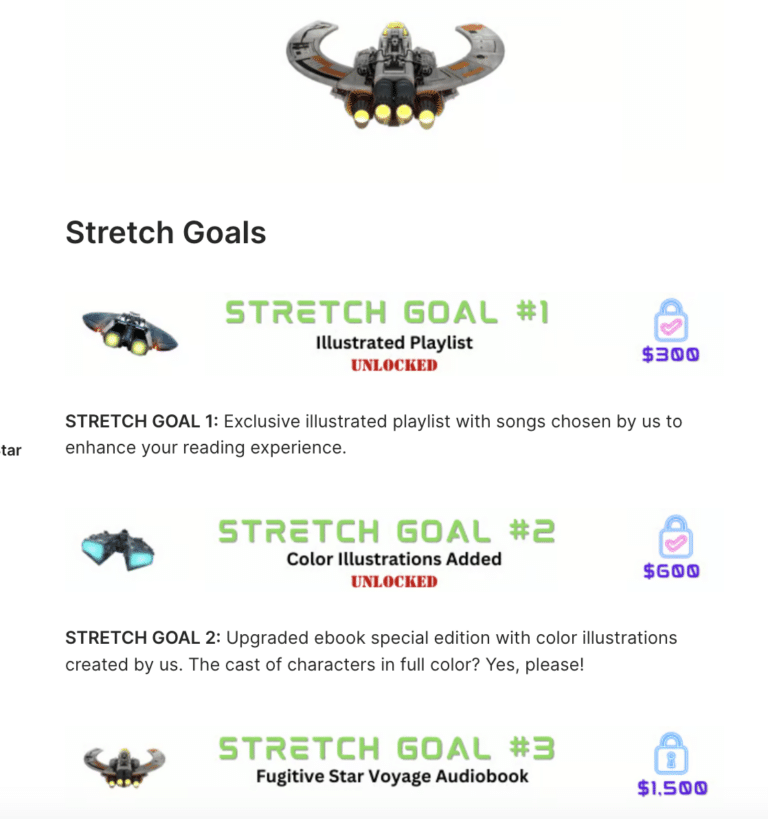
Stretch goals are additional targets set beyond the initial funding goal. The stretch goals go to everyone who backs your campaign (from the $5 level to the $500 level). Create fun goals to incentivize readers to increase their pledge or share with others. This is another great place to add digital rewards.
Examples:
- Playlist to accompany the book/series
- Ebooks of your other books
- Audiobook version of the book
- Color illustrations added
- Sprayed edges for hardcovers
Building Your Audience Before Launch
Pre-Launch Marketing
One key element during this early phase is to create a pre-launch landing page where interested readers can sign up to be notified as soon as the campaign goes live.
You need to have your campaign information added to your project page, but the only thing that shows on the front end is your graphic and a brief description of the project. You can continue to edit and add more information while it is in this phase.
These pages can be set up anywhere from 1 day to 60 days prior to launch. Kickstarter recommends setting it for 30 days or less. The purpose of this page is to build momentum for when your project does launch.
Once your pre-launch page is approved and live, announce the news to your email list and build excitement by offering exclusive previews and updates. This is also the time to actively engage with your existing audience on social media; share potential book covers, share drafts,excerpts and let them feel like they are part of your journey.
This not only builds anticipation but also strengthens the connection with your readers, making them more likely to support your campaign.
Reach out to potential backers who might not yet be in your immediate circle by participating in relevant online communities, forums, and groups where your target audience is active. By consistently showing up and providing value, you can expand your reach and build a solid foundation of support for your campaign.
Networking and Community Building
Collaborating with other authors and influencers in your genre expands your reach. This can be done through joint promotions, guest blogging, or even co-hosting online events like webinars or live Q&A sessions.
By working with other authors or influencers who have established audiences, your project gets introduced to a wider audience.
Find active reading communities online. These platforms provide an excellent opportunity to share your campaign with passionate readers who are always on the lookout for new books.
Engage in discussions, offer insights, and be genuine with your interactions. .
Managing Your Campaign
Running the Campaign
When the day arrives to make your campaign go live, your work is not done. Now it’s time to kick it in gear and step on the gas. Anyone who signed up on the pre-launch page will get notified that the campaign is now live.
Over the course of your campaign stay in contact with your backers. Thank them for their support, provide progress reports, share milestones like getting funded or reaching a stretch goal.
If someone asks you a question or leaves a comment on your campaign, respond promptly. This lets people know you care and this is important to you. It also helps to build trust and keeps up the excitement.
Promote your campaign across social media, email lists, and any other platforms where your potential backers are active. Maintaining momentum is crucial, especially during the mid-campaign plateau, so keep your promotional activities varied and engaging.
There are also paid promotions to sign up for. CraveBooks now has a Kickstarter email promotion that gets your campaign in front of thousands of engaged readers.
Setbacks can happen during a campaign. If something unexpected comes up, be proactive and communicate with your backers. This honesty helps maintain their confidence and support.
Additionally, consider running mid-campaign promotions or introducing new reward tiers to re-energize your campaign and attract new backers.
Manage Backer Expectations
Be clear about what you are offering and realistic about delivery times and project outcomes. Leave a cushion in case something comes up like a delay in printing, delivery, or you get so sick you are bedridden for a few days.
Address any concerns promptly and courteously to maintain a positive relationship. By keeping communication open and transparent, you can build trust and turn your backers into long-term fans and supporters.
Post-Campaign Actions
Fulfilling Rewards
Once your campaign ends and has successfully funded, it’s time to move to the next phase of fulfilling the rewards. Your payment from Kickstarter typically arrives about two weeks after the campaign is over. If you must wait for the money in order to fulfill the orders, that’s fine, just keep backers updated.
Create a detailed schedule that outlines each step of the fulfillment process, from ordering materials to shipping out rewards. Keep track of your progress and ensure that each task is completed on time to avoid delays.
Sending a reward survey allows you to get any additional information you may need like physical address. This is also a good time to ask if they are interested in being on your email list.
Communicate with your backers about the fulfillment progress regularly. Let them know when rewards are being produced, packaged, and shipped. If there are any delays or issues, be upfront about them and provide a clear plan for resolution.
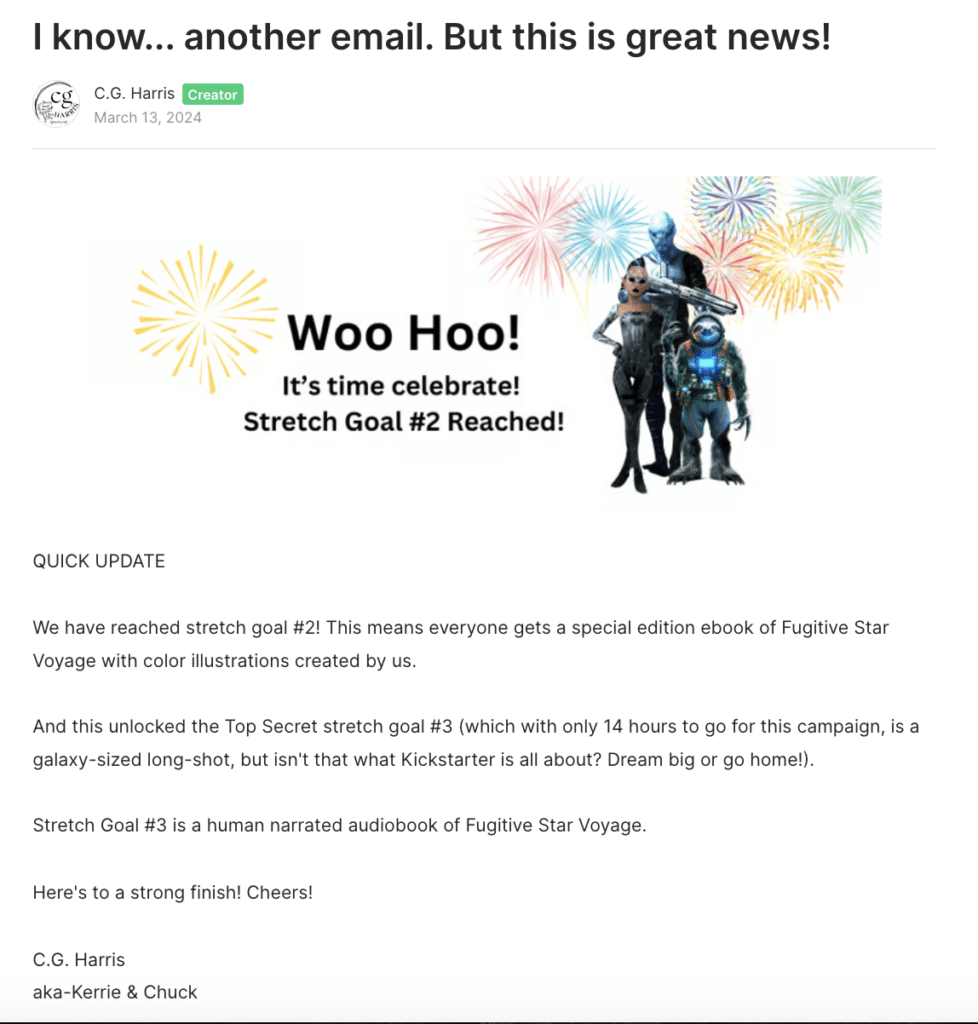
Continuing Engagement
Creating long-term fans and supporters through your Kickstarter campaign, can help you grow your reader base. Then when you launch another book or Kickstarter, you have new readers excited about your next project.
Consider offering them special perks or early access to your next book as a thank you for their support. Building a community around your work helps ensure that your backers feel valued and appreciated.
Add these new readers to your email (with their permission) to keep them up to date on what you are doing, future campaigns and projects. By nurturing these relationships, you can create a loyal fan base that will support you in future endeavors, providing a strong foundation for your ongoing success as an indie author.
Conclusion
When we look back to Michael La Ronn’s Kickstarter campaign for The Good Necromancer, it was highly successful because he did many of the strategies covered in this article.
- Modest Initial Goal: He set a low initial goal of $200, which was funded in just 14 minutes, creating strong early momentum.
- Extensive Preparation: La Ronn spent months researching and analyzing successful campaigns, supporting over 20 projects to understand best practices.
- Engaging Story and Rewards: He crafted a compelling narrative and offered attractive, well-thought-out rewards.
- Active Community Engagement: La Ronn maintained regular updates and personalized communication with backers.
Launching a book on Kickstarter offers indie authors a unique opportunity to fund their book projects, engage directly with readers, and build a loyal fan base. By setting realistic goals, creating a compelling campaign page, planning effective pre-launch marketing, and maintaining strong communication throughout the campaign, authors can successfully navigate this crowdfunding platform.
A successful campaign helps cover essential costs like editing, cover design, and printing but also allows for creative and personalized engagement with backers. Using Kickstarter to launch a book may seem too “out of the box.”
But by using the strategies in this article and investing the time and money upfront in the planning and managing our campaign, you can get your book costs covered without relying on a traditional book launch.

Introducing:
Booklinker Collections
One landing page for all your books. 100% free.
One link for easy sharing of your books across your backmatter, websites, emails, and social media.
Author
-
With over 25 years of experience in the publishing industry, Kerrie Flanagan is a highly accomplished author, writing consultant, and writing instructor. As a prominent figure in the world of writing, Kerrie brings a wealth of knowledge and passion to help authors thrive. Her dedication to her writing is evident with hundreds of published articles and over 20 books in various genres, including 15 with her coauthor under the pen name, C.G. Harris.
https://www.kerrieflanagan.com




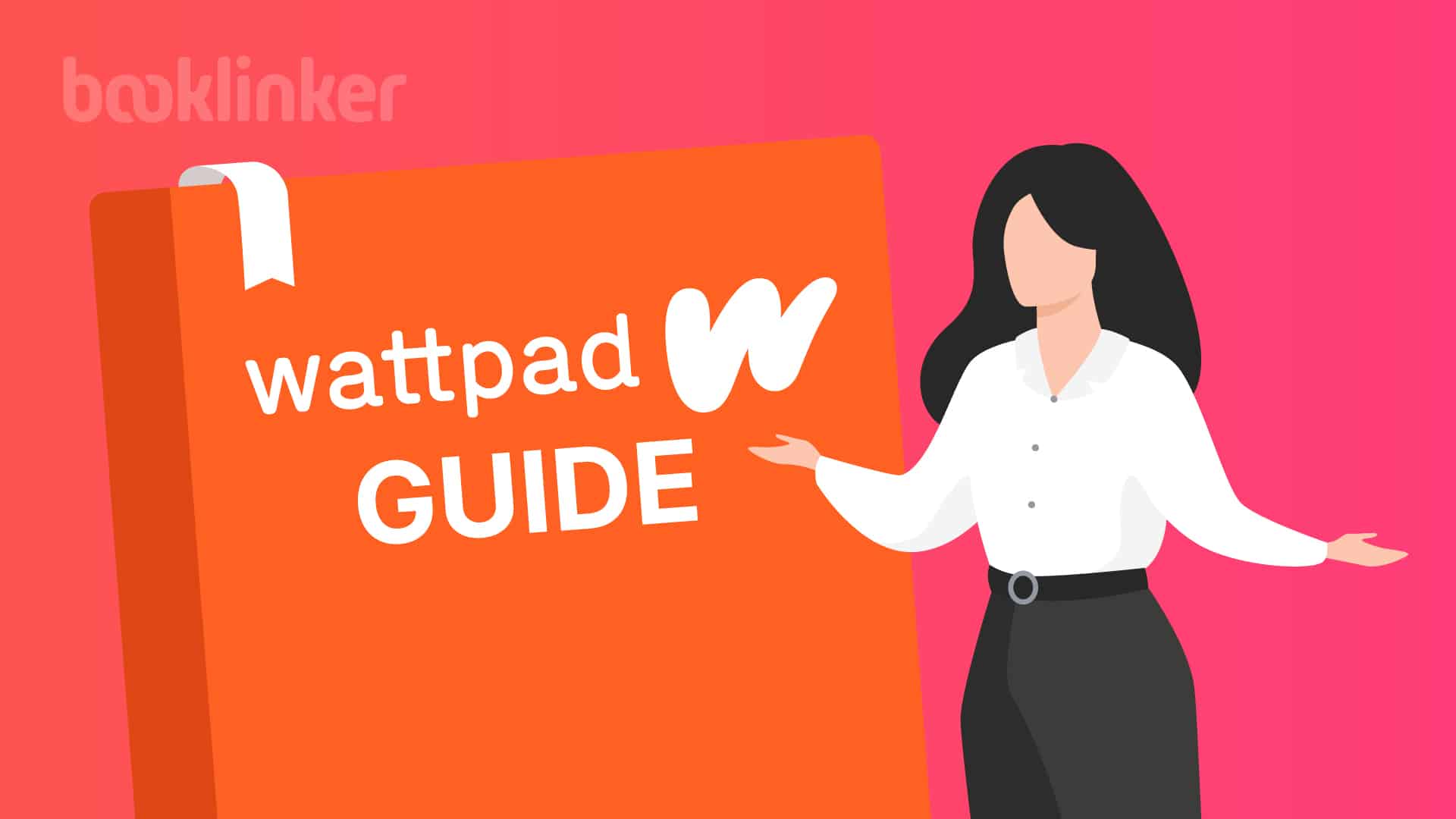
One Response
It’s disappointing to learn that Kickstarter does not allow campaigns from Africa, as it limits the opportunities for authors like myself based in South Africa. As an indie author with a passion for my work, I believe that all creators, regardless of their location, should have equal access to crowdfunding platforms. I hope that in the future, these platforms can expand their reach to better support African creators and their projects.